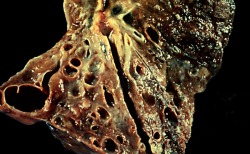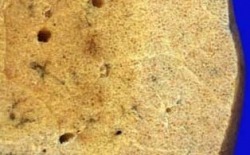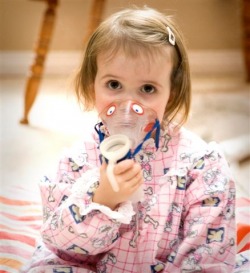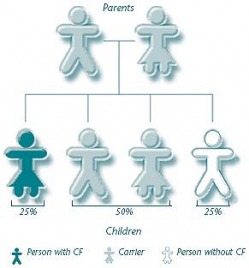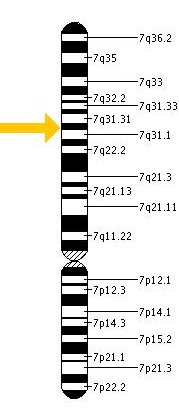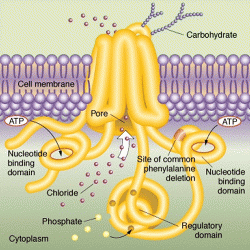This webpage was produced as an assignment for Genetics 677, an undergraduate course at the University of Wisconsin - Madison.
Introduction to Cystic Fibrosis (CF)
CF is an inherited (autosomal recessive) disease that affects nearly 30,000 people in the United States alone. CF affects the entire body, especially the respiratory and digestive systems.
Causes:
CF is caused by a mutation in the gene CFTR (Cystic Fibrosis Transmembrane Conductance Regulator). CFTR's defective protein product causes the body to produce unusually thick, sticky mucus that clogs the lungs, obstructs the pancreas, and stops natural enzymes from helping the body break down and absorb food.
Causes:
CF is caused by a mutation in the gene CFTR (Cystic Fibrosis Transmembrane Conductance Regulator). CFTR's defective protein product causes the body to produce unusually thick, sticky mucus that clogs the lungs, obstructs the pancreas, and stops natural enzymes from helping the body break down and absorb food.
Symptoms:
People afflicted with CF have a variety of symptoms including:
People afflicted with CF have a variety of symptoms including:
- very salty-tasting skin
- persistent coughing with phlegm
- frequent lung infections
- shortness of breath
- poor growth and weight gain in spite of a good appetite
- frequent greasy, bulky stools or difficulty in bowel movements
Common Diagnostic Tests:
1. Sweat Test: the absolute standard diagnostic test for CF. A high salt level in the patient's sweat is a definitive sign of the disease.
2. Immunoreactive Trypsinogen Test (IRT): a standard newborn screening test for CF. A high level of IRT suggests possible CF and requires further testing.
1. Sweat Test: the absolute standard diagnostic test for CF. A high salt level in the patient's sweat is a definitive sign of the disease.
2. Immunoreactive Trypsinogen Test (IRT): a standard newborn screening test for CF. A high level of IRT suggests possible CF and requires further testing.
Treatment/Management:
An early diagnosis of CF and a comprehensive treatment plan can improve both survival and quality of life. Common treatments to help resolve lung and nutritional problems and improve standard of living are:
1. Antibiotics to prevent and treat lung and sinus infections.
2. Inhaled medicines to help open the airways
3. DNAse enzyme replacement therapy to thin mucus
4. High caloric diet with supplementation of vitamins A, D, E, K.
5. Chest therapy: percussion of the back and chest to help dislodge mucus
Genetic Carrier Testing:
Genetic testing can be done to determine if a person has one or more copies of a mutated CF gene. Testing is performed on cells taken from a blood sample or an oral scrape. A carrier is someone who shows no signs of CF, but can pass the gene onto his/her children.
Carrier testing is often performed for couples planning on pregnancy, to assess their risk of having a child with CF. CF is an autosomal recessive disease, meaning both parents have to have the defective CF gene (be CF carriers) in order to produce a child with symptoms of CF.
Genetic testing can be done to determine if a person has one or more copies of a mutated CF gene. Testing is performed on cells taken from a blood sample or an oral scrape. A carrier is someone who shows no signs of CF, but can pass the gene onto his/her children.
Carrier testing is often performed for couples planning on pregnancy, to assess their risk of having a child with CF. CF is an autosomal recessive disease, meaning both parents have to have the defective CF gene (be CF carriers) in order to produce a child with symptoms of CF.
Introduction to CFTR Gene & CFTR Protein
The human CFTR gene's full name is:
Cystic Fibrosis Transmembrane Conductance Regulator, ATP-binding cassette, sub-family C, member 7.
The gene CFTR codes for the protein CFTR (Cystic Fibrosis Transmembrane Conductance Regulator). The CFTR protein functions as an ion channel across the cell membrane. The CFTR protein is present in tissue that produces mucus, sweat, saliva, tears, and digestive enzymes.
The CFTR protein regulates the flow of chloride, a component of salt, in response to cellular signals. The transport of chloride controls the flow of water in and out of tissues; water content maintains the fluidity of mucus.
CFTR Gene Mutations:
Over 1000 mutations have been found in the CFTR gene. Although, the majority of mutations are not associated with CF. The most common mutation is called ΔF508, a deletion of phenylalanine at position 508. This mutation causes the most common CF symptoms.
This altered protein never reaches the cell membrane, as it is recognized as defective and destroyed shortly after it is made. All serious mutations in the CFTR gene prevent the CFTR protein channel from functioning properly. An ill-functioning CFTR protein blocks the movement of salt and water into and out of cells. This causes the tissue to secrete an abnormally thick mucus, which causes the symptoms of CF.
Cystic Fibrosis Transmembrane Conductance Regulator, ATP-binding cassette, sub-family C, member 7.
The gene CFTR codes for the protein CFTR (Cystic Fibrosis Transmembrane Conductance Regulator). The CFTR protein functions as an ion channel across the cell membrane. The CFTR protein is present in tissue that produces mucus, sweat, saliva, tears, and digestive enzymes.
The CFTR protein regulates the flow of chloride, a component of salt, in response to cellular signals. The transport of chloride controls the flow of water in and out of tissues; water content maintains the fluidity of mucus.
CFTR Gene Mutations:
Over 1000 mutations have been found in the CFTR gene. Although, the majority of mutations are not associated with CF. The most common mutation is called ΔF508, a deletion of phenylalanine at position 508. This mutation causes the most common CF symptoms.
This altered protein never reaches the cell membrane, as it is recognized as defective and destroyed shortly after it is made. All serious mutations in the CFTR gene prevent the CFTR protein channel from functioning properly. An ill-functioning CFTR protein blocks the movement of salt and water into and out of cells. This causes the tissue to secrete an abnormally thick mucus, which causes the symptoms of CF.
_______________
World Map
World Map
The World Map displays exactly where this site's visitors are from - live!
_______________
References
1. Martha L Warnock's Home Page. " Practical Pathology of Chest Disease: Case Studies". Feb 5, 2010.
(Figure 1) http://pathhsw5m54.ucsf.edu/ctpath/ctpathimages/normdryxx.jpg
2. The Pathology Guy. "Cystic Fibrosis". Feb 4, 2010. (Figure 2) http://www.pathguy.com/lectures/cystic_fibrosis.jpg
3. Kin Canada: All Canadian Service Organization "Micheala" Feb 8, 2010. (Figure 3) http://www.kincanada.ca/documents/service/Michaela.JPG
4. Cystic Fibrosis Foundation: Sweat Test. Posted by CysticFibrosisUSA. Feb 2, 2010. (Youtube Video)
http://www.youtube.com/watch?v=8UCWoz6gUp8&feature=channel
5. American Congress of Obstetricians and Gynecologists (ACOG)."Chances of Having a Baby With CF".
Feb 8, 2010. (Figure 4) http://www.acog.org/publications/patient_education/bp171.cfm
6. Genetics Home Reference. "CFTR Chromosome Map". Feb 4, 2010. (Figure 5) http://ghr.nlm.nih.gov/gene=cftr
7. Genetic Disorder Research Project Wiki Site. "CFTR Protein Diagram". Feb, 8, 2010. (Figure 6)
https://runkle-science.wikispaces.com/Cystic+Fibrosis
8. Cystic Fibrosis Foundation. "What you need to know". Feb 1, 2010. http://www.cff.org/AboutCF/
9. Medline Plus. "Cystic Fibrosis" Feb 4, 2010. http://www.nlm.nih.gov/medlineplus/ency/article/000107.htm
10. Cystic Fibrosis Foundation. "Genetic Carrier Testing". Feb 5, 2010. http://www.cff.org/aboutcf/testing/geneticcarriertest/
11. Who's Among Us. Feb 2, 2010. (World Map) http://whos.amung.us/maps/
References
1. Martha L Warnock's Home Page. " Practical Pathology of Chest Disease: Case Studies". Feb 5, 2010.
(Figure 1) http://pathhsw5m54.ucsf.edu/ctpath/ctpathimages/normdryxx.jpg
2. The Pathology Guy. "Cystic Fibrosis". Feb 4, 2010. (Figure 2) http://www.pathguy.com/lectures/cystic_fibrosis.jpg
3. Kin Canada: All Canadian Service Organization "Micheala" Feb 8, 2010. (Figure 3) http://www.kincanada.ca/documents/service/Michaela.JPG
4. Cystic Fibrosis Foundation: Sweat Test. Posted by CysticFibrosisUSA. Feb 2, 2010. (Youtube Video)
http://www.youtube.com/watch?v=8UCWoz6gUp8&feature=channel
5. American Congress of Obstetricians and Gynecologists (ACOG)."Chances of Having a Baby With CF".
Feb 8, 2010. (Figure 4) http://www.acog.org/publications/patient_education/bp171.cfm
6. Genetics Home Reference. "CFTR Chromosome Map". Feb 4, 2010. (Figure 5) http://ghr.nlm.nih.gov/gene=cftr
7. Genetic Disorder Research Project Wiki Site. "CFTR Protein Diagram". Feb, 8, 2010. (Figure 6)
https://runkle-science.wikispaces.com/Cystic+Fibrosis
8. Cystic Fibrosis Foundation. "What you need to know". Feb 1, 2010. http://www.cff.org/AboutCF/
9. Medline Plus. "Cystic Fibrosis" Feb 4, 2010. http://www.nlm.nih.gov/medlineplus/ency/article/000107.htm
10. Cystic Fibrosis Foundation. "Genetic Carrier Testing". Feb 5, 2010. http://www.cff.org/aboutcf/testing/geneticcarriertest/
11. Who's Among Us. Feb 2, 2010. (World Map) http://whos.amung.us/maps/
